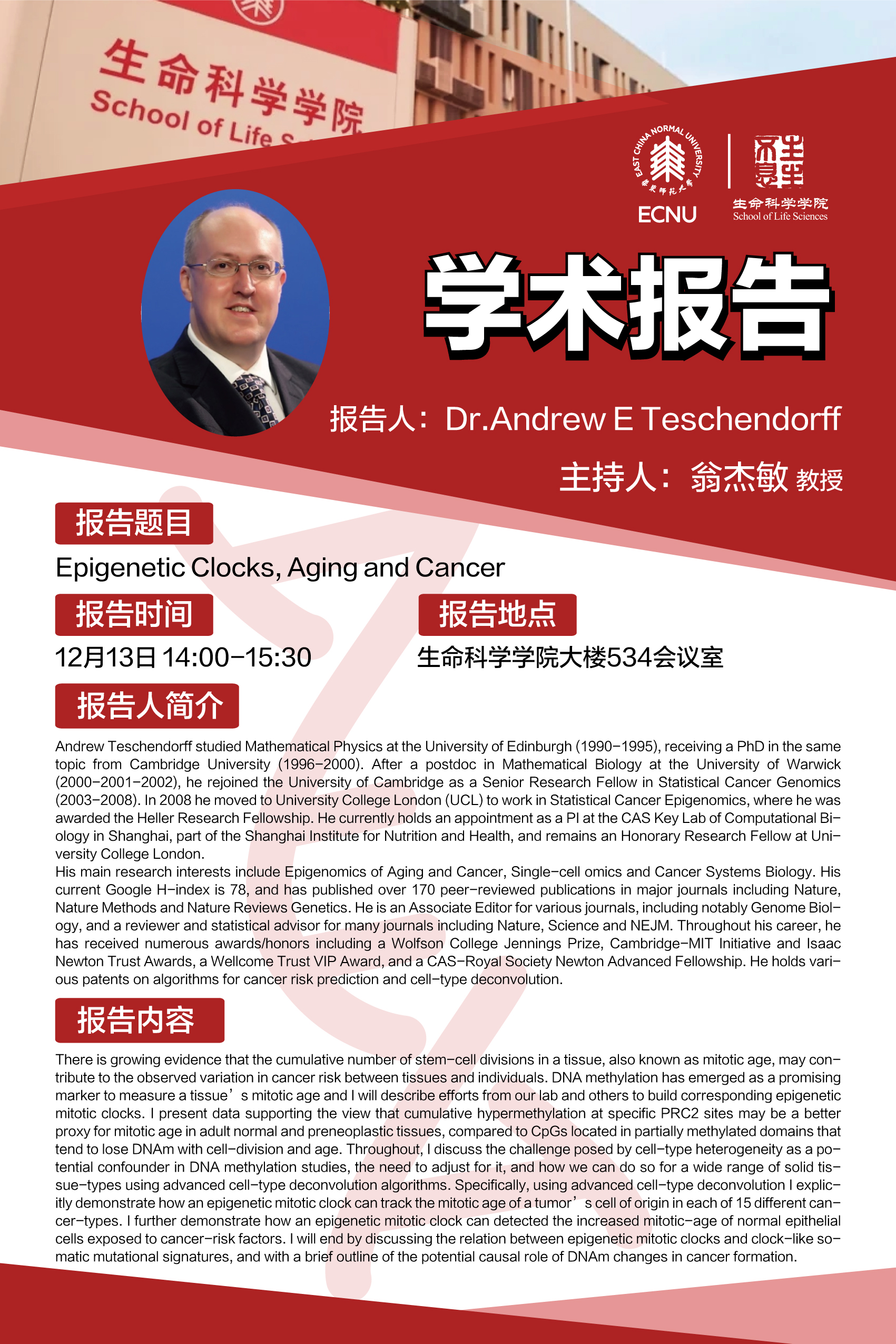报告题目:Epigenetic Clocks, Aging and Cancer
报 告 人:Dr.Andrew E Teschendorff
主 持 人:翁杰敏 教授
报告时间:2023年12月13日 14:00 - 15:30
报告地点:闵行校区生命科学学院大楼534会议室
报告人简介:
Andrew Teschendorff studied Mathematical Physics at the University of Edinburgh (1990-1995), receiving a PhD in the same topic from Cambridge University (1996-2000). After a postdoc in Mathematical Biology at the University of Warwick (2000-2001-2002), he rejoined the University of Cambridge as a Senior Research Fellow in Statistical Cancer Genomics (2003-2008). In 2008 he moved to University College London (UCL) to work in Statistical Cancer Epigenomics, where he was awarded the Heller Research Fellowship. He currently holds an appointment as a PI at the CAS Key Lab of Computational Biology in Shanghai, part of the Shanghai Institute for Nutrition and Health, and remains an Honorary Research Fellow at University College London.
His main research interests include Epigenomics of Aging and Cancer, Single-cell omics and Cancer Systems Biology. His current Google H-index is 78, and has published over 170 peer-reviewed publications in major journals including Nature, Nature Methods and Nature Reviews Genetics. He is an Associate Editor for various journals, including notably Genome Biology, and a reviewer and statistical advisor for many journals including Nature, Science and NEJM. Throughout his career, he has received numerous awards/honors including a Wolfson College Jennings Prize, Cambridge-MIT Initiative and Isaac Newton Trust Awards, a Wellcome Trust VIP Award, and a CAS-Royal Society Newton Advanced Fellowship. He holds various patents on algorithms for cancer risk prediction and cell-type deconvolution.
报告内容简介:
There is growing evidence that the cumulative number of stem-cell divisions in a tissue, also known as mitotic age, may contribute to the observed variation in cancer risk between tissues and individuals. DNA methylation has emerged as a promising marker to measure a tissue’s mitotic age and I will describe efforts from our lab and others to build corresponding epigenetic mitotic clocks. I present data supporting the view that cumulative hypermethylation at specific PRC2 sites may be a better proxy for mitotic age in adult normal and preneoplastic tissues, compared to CpGs located in partially methylated domains that tend to lose DNAm with cell-division and age. Throughout, I discuss the challenge posed by cell-type heterogeneity as a potential confounder in DNA methylation studies, the need to adjust for it, and how we can do so for a wide range of solid tissue-types using advanced cell-type deconvolution algorithms. Specifically, using advanced cell-type deconvolution I explicitly demonstrate how an epigenetic mitotic clock can track the mitotic age of a tumor’s cell of origin in each of 15 different cancer-types. I further demonstrate how an epigenetic mitotic clock can detected the increased mitotic-age of normal epithelial cells exposed to cancer-risk factors. I will end by discussing the relation between epigenetic mitotic clocks and clock-like somatic mutational signatures, and with a brief outline of the potential causal role of DNAm changes in cancer formation.
